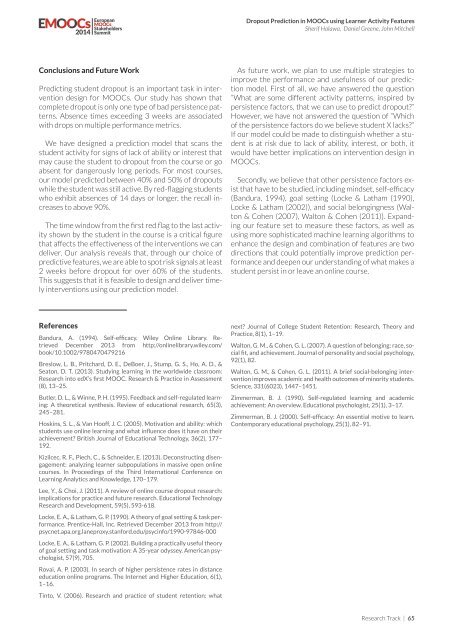zmWmQs
zmWmQs
zmWmQs
You also want an ePaper? Increase the reach of your titles
YUMPU automatically turns print PDFs into web optimized ePapers that Google loves.
Dropout Prediction in MOOCs using Learner Activity Features<br />
Sherif Halawa, Daniel Greene, John Mitchell<br />
Conclusions and Future Work<br />
Predicting student dropout is an important task in intervention<br />
design for MOOCs. Our study has shown that<br />
complete dropout is only one type of bad persistence patterns.<br />
Absence times exceeding 3 weeks are associated<br />
with drops on multiple performance metrics.<br />
We have designed a prediction model that scans the<br />
student activity for signs of lack of ability or interest that<br />
may cause the student to dropout from the course or go<br />
absent for dangerously long periods. For most courses,<br />
our model predicted between 40% and 50% of dropouts<br />
while the student was still active. By red-flagging students<br />
who exhibit absences of 14 days or longer, the recall increases<br />
to above 90%.<br />
The time window from the first red flag to the last activity<br />
shown by the student in the course is a critical figure<br />
that affects the effectiveness of the interventions we can<br />
deliver. Our analysis reveals that, through our choice of<br />
predictive features, we are able to spot risk signals at least<br />
2 weeks before dropout for over 60% of the students.<br />
This suggests that it is feasible to design and deliver timely<br />
interventions using our prediction model.<br />
As future work, we plan to use multiple strategies to<br />
improve the performance and usefulness of our prediction<br />
model. First of all, we have answered the question<br />
“What are some different activity patterns, inspired by<br />
persistence factors, that we can use to predict dropout”<br />
However, we have not answered the question of “Which<br />
of the persistence factors do we believe student X lacks”<br />
If our model could be made to distinguish whether a student<br />
is at risk due to lack of ability, interest, or both, it<br />
would have better implications on intervention design in<br />
MOOCs.<br />
Secondly, we believe that other persistence factors exist<br />
that have to be studied, including mindset, self-efficacy<br />
(Bandura, 1994), goal setting (Locke & Latham (1990),<br />
Locke & Latham (2002)), and social belongingness (Walton<br />
& Cohen (2007), Walton & Cohen (2011)). Expanding<br />
our feature set to measure these factors, as well as<br />
using more sophisticated machine learning algorithms to<br />
enhance the design and combination of features are two<br />
directions that could potentially improve prediction performance<br />
and deepen our understanding of what makes a<br />
student persist in or leave an online course.<br />
References<br />
Bandura, A. (1994). Self-efficacy. Wiley Online Library. Retrieved<br />
December 2013 from http://onlinelibrary.wiley.com/<br />
book/10.1002/9780470479216<br />
Breslow, L. B., Pritchard, D. E., DeBoer, J., Stump, G. S., Ho, A. D., &<br />
Seaton, D. T. (2013). Studying learning in the worldwide classroom:<br />
Research into edX’s first MOOC. Research & Practice in Assessment<br />
(8), 13–25.<br />
Butler, D. L., & Winne, P. H. (1995). Feedback and self-regulated learning:<br />
A theoretical synthesis. Review of educational research, 65(3),<br />
245–281.<br />
Hoskins, S. L., & Van Hooff, J. C. (2005). Motivation and ability: which<br />
students use online learning and what influence does it have on their<br />
achievement British Journal of Educational Technology, 36(2), 177–<br />
192.<br />
Kizilcec, R. F., Piech, C., & Schneider, E. (2013). Deconstructing disengagement:<br />
analyzing learner subpopulations in massive open online<br />
courses. In Proceedings of the Third International Conference on<br />
Learning Analytics and Knowledge, 170–179.<br />
Lee, Y., & Choi, J. (2011). A review of online course dropout research:<br />
implications for practice and future research. Educational Technology<br />
Research and Development, 59(5), 593-618.<br />
Locke, E. A., & Latham, G. P. (1990). A theory of goal setting & task performance.<br />
Prentice-Hall, Inc. Retrieved December 2013 from http://<br />
psycnet.apa.org.laneproxy.stanford.edu/psycinfo/1990-97846-000<br />
Locke, E. A., & Latham, G. P. (2002). Building a practically useful theory<br />
of goal setting and task motivation: A 35-year odyssey. American psychologist,<br />
57(9), 705.<br />
Rovai, A. P. (2003). In search of higher persistence rates in distance<br />
education online programs. The Internet and Higher Education, 6(1),<br />
1–16.<br />
Tinto, V. (2006). Research and practice of student retention: what<br />
next Journal of College Student Retention: Research, Theory and<br />
Practice, 8(1), 1–19.<br />
Walton, G. M., & Cohen, G. L. (2007). A question of belonging: race, social<br />
fit, and achievement. Journal of personality and social psychology,<br />
92(1), 82.<br />
Walton, G. M., & Cohen, G. L. (2011). A brief social-belonging intervention<br />
improves academic and health outcomes of minority students.<br />
Science, 331(6023), 1447–1451.<br />
Zimmerman, B. J. (1990). Self-regulated learning and academic<br />
achievement: An overview. Educational psychologist, 25(1), 3–17.<br />
Zimmerman, B. J. (2000). Self-efficacy: An essential motive to learn.<br />
Contemporary educational psychology, 25(1), 82–91.<br />
Research Track | 65


